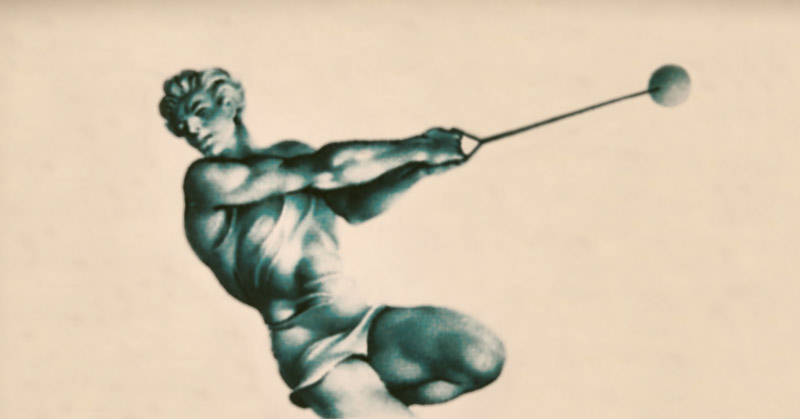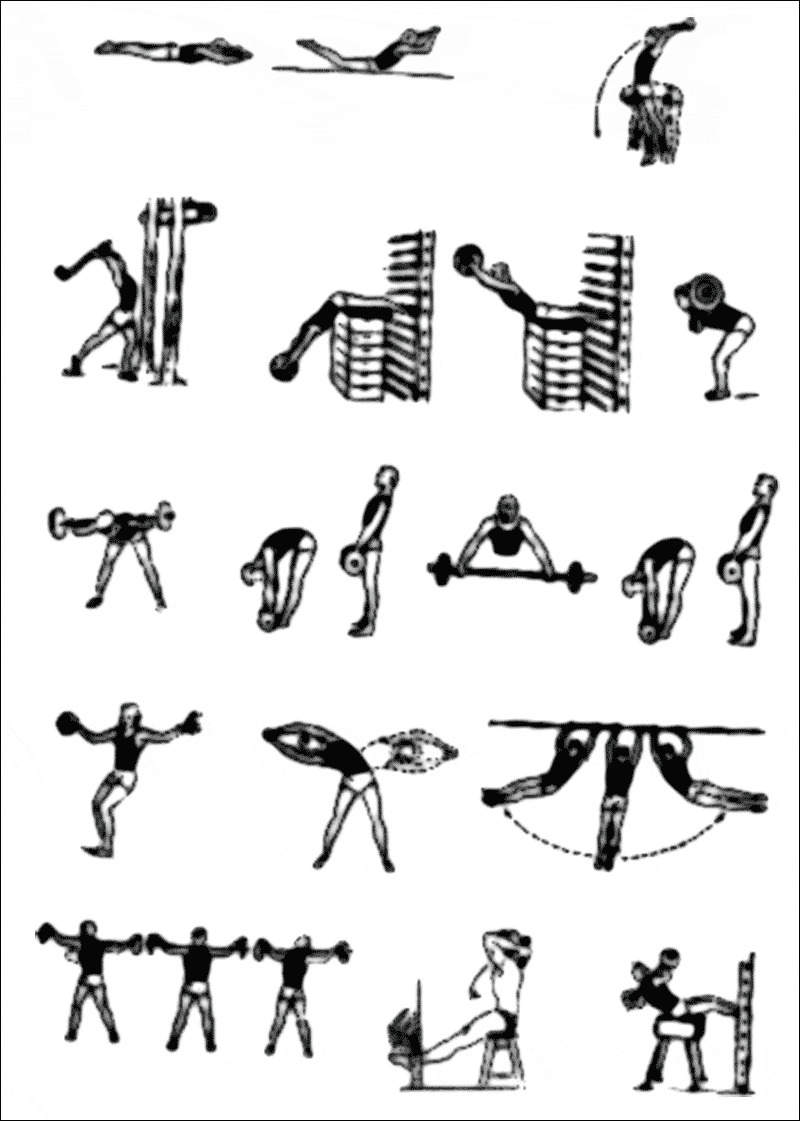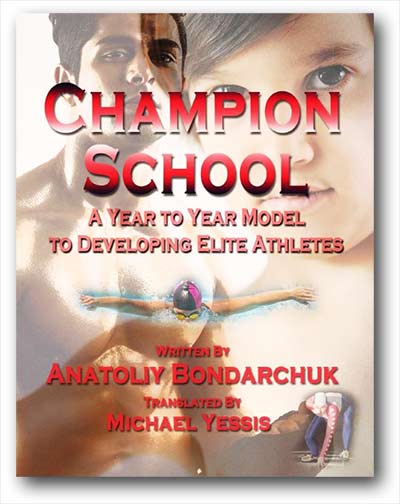
A Book Review by Jake Jensen
This article offers a comprehensive review of noted Russian strength coach Dr. Anatoliy Bondarchuk’s most recent book, Champion School: A Year to Year Model to Developing Elite Athletes. Comprised of five chapters and 231 pages, the book begins with a brief history of the Soviet Union’s methods of constructing multi-year training systems. Chapters two and three go into detail about the biological constraints of constructing these systems, such as age-sensitive periods of development and how different energy systems require different modes of development.
The final two chapters are really where readers get the most for their money. They are packed with the methods Dr. Bondarchuk has used over the years to develop Olympians such as hammer thrower Yuriy Sedykh and shot putter Justin Rodhe. The discussions include how to periodize a yearly cycle of training for athletes of various ages, optimal exercise correlations to use in each phase, and how best to peak athletes for competition.
Dr. B provides templates for progressing athletes from general physical preparation (GPP) during the off-season into specialized physical preparation (SPP) as the competitive season draws near. These templates provide much of what a coach needs to put into use immediately, including the percentage of each type of training (e.g. GPP vs. SPP) during each month leading up to competition.
For those not familiar with Dr. Bondarchuk, he is a legend in the world of sport. He won two Olympic medals in the hammer: gold at the Munich Games in 1972 and bronze at Montreal four years later. He also set world hammer records on two occasions in the late 1960s.
His athletic resume, however, pales in comparison to his coaching achievements. His athletes have won four Olympic medals, five World Championships medals, and nearly a dozen European and Pan American Games medals. Sedykh currently holds the hammer throw world record.
While impressive, achieving greatness as both an athlete and a coach is not unprecedented. However, being able to navigate the complex bureaucracy in the world of strength and conditioning is a different matter entirely. Dr. B. does just that in Champion School. Most of his published titles have focused on the science behind his methods. These methods are heavily influenced by his experience in track and field, which in many cases is difficult for team sport coaches to adapt. This title provides a framework within which any coach can take the methods that forged champions like Yuri Sedykh, and apply them to team sport athletes.
Champion School provides a complete package for constructing training in any sport. What makes this title so special is the way in which the material is presented. Dr. B takes the reader through the history of where his methods came from. He provides details about the Soviet method of long-term athlete development (LTAD). These details include the age-sensitive periods for the development of essential athletic qualities in young people. He walks the reader through these stages of development and spends an entire chapter on the various sport systems.
This part leads up to a discussion about Dr. Bondarchuk’s philosophy on athlete development. This bridge approach to discussing his training philosophy makes his hammer throws philosophy applicable to coaches in any sport. Often times in training books, content may be difficult to apply. This is usually due to rhetoric. Rhetoric is like a wall between coaches in different areas of sport. For example, a football coach doesn’t necessarily use the same jargon as a hammer throws coach.
The book tears down those walls, using language any coach can understand. Dr. Bondarchuk also includes diagrams, charts, and over 10 pages of illustrated exercises presented in groups that allow each exercise to complement one another, thereby achieving a greater training effect. Classical training manuals (Bondarchuk, Dr. Yuri Verkhoshansky, and Dr. Vladimir Zatsiorsky) often cite Soviet methods of physical development. These methods date back to the 1950s when Russian scientists began studying how to optimize physical development over an entire life cycle. They made great strides in understanding the role of age-sensitive periods of training. For example, flexibility capabilities increase to a much greater degree in the pre-peak height velocity (PHV) stages of growth as compared to post-PHV.
There are also stages where speed and power are more sensitive to improvements. These stages are variable, based on an array of factors including gender. For boys, the speed-sensitive ages are 7–9 and for girls 10–12. Dr. B. lays out all these age periods and accompanies them with expert discussion. This discussion occupies a large portion of Chapter 2.
After laying the groundwork for understanding an LTAD system in Chapter 2, Dr. B. introduces the biological systems that factor into athlete preparation in Chapter 3. These guidelines cover general topics like strength and speed as well as more acute adaptations. For example, there is a section dedicated to developing anaerobic alactic output, or “speed endurance” as he puts it. Here the reader will find references to energy systems critical to performing this type of work, such as the phosphocreatine system which is the primary metabolic function fueling high-intensity exercise.
He goes on to suggest the best practices for developing this type of power, providing sets and reps with their appropriate rest times. This type of information is especially useful for team sport coaches, as it provides a scientific measuring stick for base-conditioning work. The discussion in Chapter 3 also includes some of Dr. B’s famous complex method training templates that are organized according to periods of developing peak condition. Here is an example:
Periods of Development of Sports Form |
Exercise Complexes
|
Zones of Intensity (%) |
1
|
• Run with a high thigh lift – 20 m • Run with a whipping out of the shin – 20 m • 30 m run with a high start |
80 80 95 |
2
|
• Run with a high thigh lift – 30 m • Run with a whipping out of the shin – 30 m • Run from blocks – 30 m |
80 80 95 |
3
|
• Run with a high thigh lift – 50 m • Run with a shin swing out – 50 m • Run from a standing start – 50 m • Run from blocks – 40 m |
80 80 95 95 |
4
|
• Run with a high thigh lift – 60 m • Run, jumping from leg to leg – 30 m • Run from blocks – 60 m |
90 80 95-100 |
5
|
• Run from a flying start – 20 m • Hurdle run with a high thigh lift – 30 m |
95-100 95-100 |
6
|
• Run with a high thigh lift – 60 m • Run from blocks – 40 m • Run, jumping from leg to leg – 60 m |
85 95-100 90 |
One of the possible variants of distribution of training means over 20 periods of sports form development (the rest of the 20 periods are in the book, as this is an excerpt)
Chapter 3 also includes ideas for structuring training volume, according to both total hours and the type of work being performed. In the chart below, Dr. B lays out a 4-stage (1-year) cycle of training and details how much of each type of training should be included in each phase. GPP consists of exercises that don’t relate in form to the competition exercises. For a baseball player, for example, this would be jumping, hopping, and squatting.
SP stands for special preparation and includes exercises that vaguely resemble competition movements. For an American football player, this would be change-of-direction drills that require the athlete to stop and start laterally.
SPP is exercises are exactly or very closely resemble competition movements. For an American football player, this would be running plays at full speed without a defender, or helmet-only without shoulder pads.
The fourth phase ends as competition begins, or the start of the season. For soccer players this would be a week or two prior to their first match.

Figure 1. Sample exercises.
Total Hours
|
400-500
|
600-800
|
800-1200
|
1000-1300
|
SPP%
|
15%
|
40%
|
60%
|
55%
|
SP%
|
50%
|
40%
|
25%
|
25%
|
GPP%
|
30%
|
20%
|
15%
|
10%
|
Stages
|
1
|
2
|
3
|
4
|
This type of loading chart makes the prescription of training loads much easier. The above template is a general guide that serves as an example of what a tapered loading program would look like. Dr. Bondarchuk provides more than 10 different ways to structure the annual relationships between GPP, SPP, SP and competition phases.
Chapter 3 concludes with an awesome addition that hasn’t been included in any of Dr. B’s previous books, at least to my knowledge: a 12-page encyclopedia of movements which he has combined into complexes to achieve a greater training effect than if performed independent of one another. Really cool stuff—take a look.
The discussion of scientific principles for athlete development—combined with the charts explaining the loads in Chapter 3—make a good foundation for the meaty discussion comprising the rest of the book. The bulk of Chapter 4 includes similar templates with each method for development. The sports form development methods outlined throughout the chapter fit a variety of sports. This works great for team sport coaches because some offseasons provide more time to train than others.
The stage-complex method on page 154 is an example of the type of sports form development methods in the chapter. This particular method adapts the SP phase to work in conjunction with short GPP and SPP phases. Athletes who benefit from this model of development would have a relatively long offseason and spend the bulk of their training in sport-specific work. This would work well for American football players who do a large percentage of their off-season training in the SP and SPP phases (think spring football and fall camp). This chapter also includes sections dedicated exclusively to methods for preparing athletes in particular sports such as track and field jumps and throws, cyclical endurance events, individual events, fencing, team sports, shooting sports, and strength sports.
As Chapter 4 wraps up the discussion on methods for developing sports form, Chapter 5 rounds out the development equation by outlining a variety of means that can be distributed across these different methods. It focuses on volume and intensity as opposed to just the phases of preparation discussed in the previous chapter. Dr. B frequently quotes A.N. Vorobyev, a famous Soviet weightlifter and coach.
There are seven basic means in the final 30 pages. These means vary from “wave-form” —focusing on the exercises selected for training—to “variational,” which primarily relies on combining low intensity and very high-intensity loads in the same micro-cycles.
I was most interested in the “jump-form” means for distributing volume and intensity. In this method, volume training is combined with high-intensity weight lifting. I like this method because it closely resembles the western conjugate style of training. It maintains a certain level of GPP while congruently building up SPP. I used this style of training for my powerlifting prep, so reading about it was pretty cool.
The material included in this book is unprecedented as far as Bondarchuk’s books are concerned. Compared to his previous titles, there is very little discussion about the science of correlational analysis. The rhetoric in this book is acutely targeted at the machinery of training the athlete over the entire life cycle, from cradle to podium. This approach makes it much easier to put the information into practice. I recommend it to sport or strength coaches looking to improve their athletes’ preparation. It is available for purchase through the publisher’s website and also Elitefts and HMMR Media.
ABOUT THE AUTHOR
Jake Jensen is strength and conditioning coaching assistant at Brigham Young University, where he works for the director of football performance. He is currently finishing his undergraduate degree in sports science with a minor in nutrition at the University of Utah. His areas of experience include integration of sports performance technologies such as POLAR, Catapult, and Omegawave as well as translating Russian training texts.
Please share this article so others may benefit.
[mashshare]


